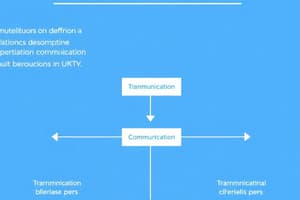Podcast
Questions and Answers
What are the four categories into which communication types can be classified?
What are the four categories into which communication types can be classified?
- Verbal, visual, auditory, written
- Spoken, visual, digital, interactive
- Verbal, non-verbal, written, mediated (correct)
- Verbal, digital, face-to-face, mediated
Which form of communication involves gestures, facial expressions, eye contact, and posture?
Which form of communication involves gestures, facial expressions, eye contact, and posture?
- Verbal communication
- Non-verbal communication (correct)
- Mediated communication
- Digital communication
What is the distinguishing factor that sets human communication apart from lower species according to Lucas (2017)?
What is the distinguishing factor that sets human communication apart from lower species according to Lucas (2017)?
- Use of an organized system of words for communication (correct)
- Use of digital devices for communication
- Use of complex sign languages
- Ability to communicate telepathically
Which model suggests that communication can move back and forth between different communication methods?
Which model suggests that communication can move back and forth between different communication methods?
What type of communication involves any form of communication involving words spoken out loud?
What type of communication involves any form of communication involving words spoken out loud?
How does noise impact communication according to the text provided?
How does noise impact communication according to the text provided?
Why do we communicate to influence others?
Why do we communicate to influence others?
Which of the following best describes the principle that states communication is continuous?
Which of the following best describes the principle that states communication is continuous?
What aspect of communication involves the understanding of a situation to construct a message?
What aspect of communication involves the understanding of a situation to construct a message?
How can non-verbal behavior play a role in communication?
How can non-verbal behavior play a role in communication?
What distinguishes communication as purposive?
What distinguishes communication as purposive?
How does communication happening without much thought differ from communication based on a learned script?
How does communication happening without much thought differ from communication based on a learned script?
Which level of communication involves communication within the person and is sometimes referred to as 'self-talk'?
Which level of communication involves communication within the person and is sometimes referred to as 'self-talk'?
Which type of communication occurs between two or more people who establish communicative relationships?
Which type of communication occurs between two or more people who establish communicative relationships?
What is the level of communication where the message is intended for a large crowd or audience?
What is the level of communication where the message is intended for a large crowd or audience?
Which form of communication is carried out using information and communication technology (ICT)?
Which form of communication is carried out using information and communication technology (ICT)?
Which type of communication refers to the formal method of ordering, instructing, or sending messages through documents like letters, circulars, and memos?
Which type of communication refers to the formal method of ordering, instructing, or sending messages through documents like letters, circulars, and memos?
'Self-talk' is associated with which level of communication?
'Self-talk' is associated with which level of communication?
Flashcards are hidden until you start studying
Study Notes
Reasons for Communication
- We communicate to fulfill social obligations, such as greeting people and talking to meet social expectations.
- We communicate to develop relationships, deepen and maintain them through communication.
- We communicate to exchange information, which can be obtained through reading, observations, media, and communication with others.
- We communicate to influence others, such as encouraging or persuading them towards something.
Principles of Communication
- Communication is purposive, meaning it has a purpose, whether trivial or significant.
- Communication is continuous, even silence communicates something, and we should be aware of our non-verbal behavior.
- Communication messages vary in conscious encoding, meaning they can be spontaneous, based on a learned script, or constructed based on the situation.
Types of Communication
- Communication can be classified into four categories: verbal, non-verbal, written, and mediated.
- Verbal communication involves words, spoken, and is based on an organized system of words.
- Non-verbal communication includes body language, facial expressions, eye contact, posture, and the sound of our voice.
- Written communication is a formal method of communication, produces a permanent record, and includes sending messages, orders, or instructions in writing.
- Mediated communication is carried out using information communication technology (ICT).
Levels of Communication
- Communication levels include intrapersonal, interpersonal, and public communication.
- Intrapersonal communication occurs within the person, also referred to as cognitive or personal communication or “self-talk”.
- Interpersonal communication occurs between two or more people who establish communicative relationships.
- Public communication is intended for a large crowd or audience, and can be direct or indirect.
Non-Verbal Communication
- Non-verbal communication is a type of communication that does not make use of words but may enhance or change the linguistic code.
- One common misconception is that what is being said is more important than how it is being said.
Studying That Suits You
Use AI to generate personalized quizzes and flashcards to suit your learning preferences.




